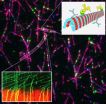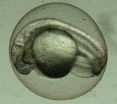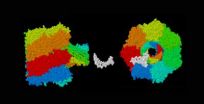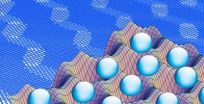(Press-News.org) AMHERST, Mass. – Recently biologists at the University of Massachusetts Amherst led by Wei-lih Lee have identified a new molecular player in asymmetric cell division, a regulatory protein named She1 whose role in chromosome- and spindle positioning wasn't known before. Asymmetric cell division is important in the self-renewal of stem cells and because it ensures that daughter cells have different fates and functions.
When a fertilized egg develops in a fruit fly or a human being, the number of asymmetric cell divisions must be precisely balanced by symmetric cell divisions, Lee explains. He has spent years studying the cell's molecular engine called dynein, which in many cases controls how embryos accomplish asymmetric cell division, though exactly how is not completely understood.
Now, Lee and postdoctoral researcher Steven Markus, with undergraduate Katelyn Kalutkiewicz, in experiments supported by the NIH's National Institute of General Medical Sciences, have identified She 1 as the first known regulator of asymmetric cell division that inhibits the dynein engine, but surprisingly also promotes asymmetric division. Their work is described in an early online edition of Current Biology and will appear in the December 4 print edition.
Working with common yeast, Lee explains, "With this study, we've looked deeper than ever before into dynein and its role in asymmetric cell division. This is a highly conserved process that's very important to human development, to tissue differentiation and the self-renewing process of stem cells. Many had hypothesized that dynein influences the outcome of the division by pulling on the mitotic spindle, the intricate machine responsible for separating chromosomes. How dynein knows which direction to pull the spindle had become the holy grail of this research."
When a cell is ready to divide asymmetrically, dynein molecules move to its outer wall in opposite directions by riding along microtubules "tracks" and anchoring in the wall like tent stakes. Until Lee and colleagues' recent discovery of She1's role, biologists believed dynein acted alone to direct the spindle apparatus between them, pulling chromosomes apart like taffy to form two daughter cells. They thought She1 seemed to be involved in dynein distribution, as it was often observed on the microtubule tracks along which dynein draws the spindle apparatus.
To explore She1's secrets, Lee and his team used Total Internal Reflection Fluorescence (TIRF) microscopy, which allows them to visualize single molecules at high resolution. They can watch the dynein engine as it powers along the microtubule tracks.
"We were curious," Lee notes. "We knew She1 was present but we didn't know why. So we decided to do some biochemistry with it in the microscope. Steven purified the protein and designed experiments to see if it interacted with the motor protein. And it did."
In fact, the UMass Amherst research team found that She1 interacts with dynein only when the motor protein is on the microtubule cable and the motor is moving on the track, never elsewhere. "We observed them colliding on the track, then binding. The new concept is that these microtubules become different," Lee adds. "Discovering that She1 can block dynein's motoring totally changed our thinking about how the spindle is being pulled in the cell."
The researchers were surprised because observing its behavior, one would predict that She1 inhibits asymmetric division by blocking dynein. It turns out that is not true. Instead, She1 actively promotes asymmetric cell division by changing its local underlying microtubules. Tracks containing She1 no longer permit dynein to pass.
It's a subtle difference, Lee acknowledges, but important. He clarifies, "We think the microtubule tracks might be 'licensed,' so to speak, by She1. The idea had been that the engine was always 'on' and pulling. However, now we have identified this new player with the ability to specifically regulate this pulling very locally. If there's high She1 concentration on one side of the spindle, dynein can only pull from the other side, thus specifying the direction of the pulling."
There is no counterpart to She1 found in common yeast yet known in humans, but Lee and colleagues expect a similar protein will be discovered that regulates and directs dynein's pulling in asymmetric cell division.
INFORMATION:
In addition to NIH, this work was supported by awards to Kalutkiewicz from the American Heart Association Undergraduate Summer Fellowship Program, the UMass Amherst Commonwealth Honors College Research Assistant Fellowship Program and the Howard Hughes Medical Institute-sponsored Summer Research Internship Program in the UMass Amherst Biology Department.
UMass Amherst cell biologists identify new protein key to asymmetric cell division
Biologists have identified a new molecular player in asymmetric cell division, a protein named She1 whose role wasn't known before - This is important for self-renewal of stem cells and ensures that daughter cells have different fates and functions
2012-11-08
ELSE PRESS RELEASES FROM THIS DATE:
Scientists reveal key protein interactions involved in neurodegenerative disease
2012-11-08
JUPITER, FL, November 8, 2012 – Scientists from the Florida campus of The Scripps Research Institute (TSRI) have defined the molecular structure of an enzyme as it interacts with several proteins involved in outcomes that can influence neurodegenerative disease and insulin resistance. The enzymes in question, which play a critical role in nerve cell (neuron) survival, are among the most prized targets for drugs to treat brain disorders such as Parkinson's disease, Alzheimer's disease and amyotrophic lateral sclerosis (ALS).
The study was published online ahead of print ...
Unique spinal nerve cell activity discovery announced by University of Leicester biologists
2012-11-08
Scientists from the University of Leicester have hit upon unique forms of spinal nerve activity that shape output of nerve cell networks controlling motor behaviours.
The breakthrough in the Department of Biology at the University of Leicester is announced today (5pm GMT on Thursday Nov 8) in the journal Current Biology. The three- year study was funded by the Biotechnology and Biological Sciences Research Council (BBSRC).
Although the neural basis of motor control has been studied for over a century, the processes controlling maturation of locomotor behaviours – like ...
Rethinking body mass index for assessing cancer risk
2012-11-08
November 8, 2012 — (Bronx, NY) — A study by researchers at Albert Einstein College of Medicine of Yeshiva University suggests that body mass index (BMI)—the most commonly used weight-for-height formula for estimating fatness—may not be the best measure for estimating disease risk, and particularly the risk of certain types of cancer. The study was published today in the online edition of the American Journal of Epidemiology.
BMI is calculated by dividing a person's weight (in kilograms) by his or her height in meters squared, or W/H2. Most of the early studies that ...
Cells from skin create model of blinding eye disease
2012-11-08
MADISON — For the first time, Wisconsin researchers have taken skin from patients and, using induced pluripotent stem cell (iPSC) technology, turned them into a laboratory model for an inherited type of macular degeneration.
Dr. David Gamm, director of the UW's McPherson Eye Research Institute, said that while Best disease is relatively rare, having a patient-specific model of the eye disease, which destroys the macula of the retina, could lead to a greater understanding of more common eye disorders such as age-related macular degeneration.
"This model gives us a chance ...
Dream symbols could help in psychotherapy
2012-11-08
Dream images could provide insights into people's mental health problems and may help with their treatment, according to a psychology researcher from the University of Adelaide.
Dr Lance Storm, a Visiting Research Fellow with the University of Adelaide's School of Psychology, has been studying dream symbols (or "archetypes") and their meanings, as described by the famous psychologist and psychiatrist, Carl Jung.
In the early 1900s, Jung proposed that these archetypes were ancient images stemming from humans' collective unconscious. He believed that dream symbols carried ...
Injection is the best method for cutting ammonia emissions from slurry spreading on lands
2012-11-08
In order to contribute to the development of the primary sector and environmental care, the Basque Institute of Agricultural Research and Development, NEIKER-Tecnalia, has analysed various ways of spreading slurry on arable land to determine the most appropriate way of cutting the amount of ammonia that is released into the atmosphere.
The three methods studied were: the traditional splash plate or fan method, hanging pipes, or injection. The last one turned out to be the most environmentally friendly in terms of ammonia emissions (NH3), as it achieves a 93% cut in NH3 ...
Carbon dioxide – our salvation from a future ice age?
2012-11-08
Mankind's emissions of fossil carbon and the resulting increase in temperature could prove to be our salvation from the next ice age. According to new research from the University of Gothenburg, Sweden, the current increase in the extent of peatland is having the opposite effect.
"We are probably entering a new ice age right now. However, we're not noticing it due to the effects of carbon dioxide", says researcher Professor Lars Franzén.
Looking back over the past three million years, the earth has experienced at least 30 periods of ice age, known as ice age pulses. ...
Pull with caution
2012-11-08
As nanotechnology progresses, it becomes increasingly important to know in detail the dynamics of the nanoworld (the world at the scale of a millionth of a millimeter). What happens, for example, when we try to drive a polyelectrolyte (a long chain of electrically charged molecules, such as DNA) through a nanopore if knots cause the translocation process to jam? It's not a pointless question, because now a new DNA sequencing method to electrochemically analyze every single strand by driving it through a nanopore, is being developed. Since those strands tend to tangle up ...
Environmentally friendly chemistry important for manufacturing pharmaceuticals
2012-11-08
Limiting the quantity of catalysts – substances that trigger a chemical reaction – used in the manufacture of pharmaceuticals is important, and research from the University of Gothenburg, Sweden, has now demonstrated that small quantities of copper work well in this respect.
"This is an important finding, not just academically but also for industry," says chemist Per-Fredrik Larsson.
Catalysis is an incredibly valuable tool in the field of chemistry, with the Haber-Bosch process being one of the most important catalytic processes in the world. It is used to manufacture ...
What if the nanoworld slides
2012-11-08
A study published by Andrea Vanossi, Nicola Manini and Erio Tosatti - three SISSA researchers - in PNAS (Proceedings of the National Academy of Sciences) provides a new tool to better understand how sliding friction works in nanotribology, through colloidal crystals.
By theoretically studying these systems of charged microparticles, researchers are able to analyze friction forces through molecular dynamics simulations with accuracy never experienced before.
"There are several and very concrete potentialities", stated Andrea Vanossi, one of the members of the research ...
LAST 30 PRESS RELEASES:
New expert guidance urges caution before surgery for patients with treatment-resistant constipation
Solar hydrogen can now be produced efficiently without the scarce metal platinum
Sleeping in on weekends may help boost teens’ mental health
Study: Teens use cellphones for an hour a day at school
After more than two years of war, Palestinian children are hungry, denied education and “like the living dead”
The untold story of life with Prader-Willi syndrome - according to the siblings who live it
How the parasite that ‘gave up sex’ found more hosts – and why its victory won’t last
When is it time to jump? The boiling frog problem of AI use in physics education
Twitter data reveals partisan divide in understanding why pollen season's getting worse
AI is quick but risky for updating old software
Revolutionizing biosecurity: new multi-omics framework to transform invasive species management
From ancient herb to modern medicine: new review unveils the multi-targeted healing potential of Borago officinalis
Building a global scientific community: Biological Diversity Journal announces dual recruitment of Editorial Board and Youth Editorial Board members
Microbes that break down antibiotics help protect ecosystems under drug pollution
Smart biochar that remembers pollutants offers a new way to clean water and recycle biomass
Rice genes matter more than domestication in shaping plant microbiomes
Ticking time bomb: Some farmers report as many as 70 tick encounters over a 6-month period
Turning garden and crop waste into plastics
Scientists discover ‘platypus galaxies’ in the early universe
Seeing thyroid cancer in a new light: when AI meets label-free imaging in the operating room
Neutrophil-to-lymphocyte ratio may aid risk stratification in depressive disorder
2026 Seismological Society of America Annual Meeting
AI-powered ECG analysis offers promising path for early detection of chronic obstructive pulmonary disease, says Mount Sinai researchers
GIMM uncovers flaws in lab-grown heart cells and paves the way for improved treatments
Cracking the evolutionary code of sleep
Medications could help the aging brain cope with surgery, memory impairment
Back pain linked to worse sleep years later in men over 65, according to study
CDC urges ‘shared decision-making’ on some childhood vaccines; many unclear about what that means
New research finds that an ‘equal treatment’ approach to economic opportunity advertising can backfire
Researchers create shape-shifting, self-navigating microparticles
[Press-News.org] UMass Amherst cell biologists identify new protein key to asymmetric cell divisionBiologists have identified a new molecular player in asymmetric cell division, a protein named She1 whose role wasn't known before - This is important for self-renewal of stem cells and ensures that daughter cells have different fates and functions





